Entry tags:
Travelogue
It stopped raining at breakfast yesterday, and was glorious the rest of the day. We actually visited three castles: Dinefwr, Carreg Cennen, and Dryslwyn.

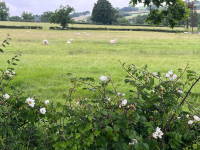
A quarter mile from our B&B was the entrance to Parc Dinefwr, which has at one end a Victorian mansion that we didn't visit,

some lovely woods and meadows in the middle, and at the far end Castell Dinefwr.


When we got to the top of the castle and looked around, we immediately thought "It's the Shire!"

Castell Carreg Cennen is a more high-profile castle, with a visitor's centre, an admission charge, an ice cream shop, and all that. It's quite dramatic from the approach road

as well as from up close

The interior is fairly well preserved, as medieval castles go: this is the second-story "Lord's Chamber"

All those fortifications are scarcely needed, because the landscape provides pretty good protection

A few miles away is the less-touristed, scarcely-even-signed Castell Dryslwyn, on top of a hill

in the middle of a scenic valley
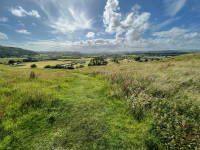

Interestingly, the top of the hill contained a village of 30-some houses outside the walls of the castle; you can still see their outlines in the grass

And such a view!
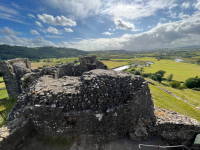
Drove from the Brecon Beacons into Pembrokeshire, checked into our B&B, and got dinner at a pub around the corner.
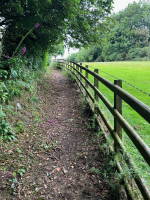

This morning I woke up to find the weather foggy but not actively raining, so I went for a walk in the neighborhood,
including some lovely views of the coastline and the harbor, then returned to the B&B, had breakfast, and chatted with another guest and the owner for an hour or so before waking D. We found a shop where we could buy some quiche slices, got into the car, and drove through the rain to

St. David’s, “the smallest city in Britain” at 1852 people (it’s a city because it has a cathedral). It was still raining, so we walked around inside the (still functioning) cathedral, of which
 the nave dates to the 12th century and the rest to the 14th, with substantial restoration in the late 19th.
the nave dates to the 12th century and the rest to the 14th, with substantial restoration in the late 19th.
 There are still a lot of medieval encaustic tiles in the floor, as well as some 19th-century replacements.
There are still a lot of medieval encaustic tiles in the floor, as well as some 19th-century replacements.
The original shrine of St. David was destroyed by Viking raiders in the 9th century, a new one was built in the 13th or so, it fell into disrepair, and was restored with medieval-style, medieval-materials paintings about fifteen years ago. Geraldus Cambrensis is allegedly buried there, as are the Welsh princes Rhys Gryffydd and Rhys Greg (sp?)
A few steps away from the still-functioning St David's Cathedral are the ruins of the medieval Bishop's Palace, which is your average castle minus the military fortifications: it has a great hall, a kitchen, some private quarters, office space, storage rooms, etc. I was particularly struck by the construction of the tunnels that connect the various storage rooms.
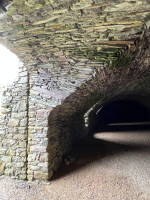


And then it stopped raining, so we walked a third of a mile out of town to the chapel and holy well of St. Non, St. David’s mother. She was apparently caught by the seashore in a thunderstorm when it was time to give birth to him (about CE 500), and at the moment of his birth, a lightning bolt opened a spring of pure water, which is still there (albeit not flowing due to the drought).
It’s down by the seashore cliffs, so we walked a little way along the seashore walk (which IIUC goes all the way around Pembrokeshire). Stunning scenery, glorious weather.





A quarter mile from our B&B was the entrance to Parc Dinefwr, which has at one end a Victorian mansion that we didn't visit,

some lovely woods and meadows in the middle, and at the far end Castell Dinefwr.


When we got to the top of the castle and looked around, we immediately thought "It's the Shire!"

Castell Carreg Cennen is a more high-profile castle, with a visitor's centre, an admission charge, an ice cream shop, and all that. It's quite dramatic from the approach road

as well as from up close

The interior is fairly well preserved, as medieval castles go: this is the second-story "Lord's Chamber"

All those fortifications are scarcely needed, because the landscape provides pretty good protection

A few miles away is the less-touristed, scarcely-even-signed Castell Dryslwyn, on top of a hill

in the middle of a scenic valley


Interestingly, the top of the hill contained a village of 30-some houses outside the walls of the castle; you can still see their outlines in the grass

And such a view!

Drove from the Brecon Beacons into Pembrokeshire, checked into our B&B, and got dinner at a pub around the corner.


This morning I woke up to find the weather foggy but not actively raining, so I went for a walk in the neighborhood,
including some lovely views of the coastline and the harbor, then returned to the B&B, had breakfast, and chatted with another guest and the owner for an hour or so before waking D. We found a shop where we could buy some quiche slices, got into the car, and drove through the rain to

St. David’s, “the smallest city in Britain” at 1852 people (it’s a city because it has a cathedral). It was still raining, so we walked around inside the (still functioning) cathedral, of which
 the nave dates to the 12th century and the rest to the 14th, with substantial restoration in the late 19th.
the nave dates to the 12th century and the rest to the 14th, with substantial restoration in the late 19th. There are still a lot of medieval encaustic tiles in the floor, as well as some 19th-century replacements.
There are still a lot of medieval encaustic tiles in the floor, as well as some 19th-century replacements.The original shrine of St. David was destroyed by Viking raiders in the 9th century, a new one was built in the 13th or so, it fell into disrepair, and was restored with medieval-style, medieval-materials paintings about fifteen years ago. Geraldus Cambrensis is allegedly buried there, as are the Welsh princes Rhys Gryffydd and Rhys Greg (sp?)
A few steps away from the still-functioning St David's Cathedral are the ruins of the medieval Bishop's Palace, which is your average castle minus the military fortifications: it has a great hall, a kitchen, some private quarters, office space, storage rooms, etc. I was particularly struck by the construction of the tunnels that connect the various storage rooms.



And then it stopped raining, so we walked a third of a mile out of town to the chapel and holy well of St. Non, St. David’s mother. She was apparently caught by the seashore in a thunderstorm when it was time to give birth to him (about CE 500), and at the moment of his birth, a lightning bolt opened a spring of pure water, which is still there (albeit not flowing due to the drought).
It’s down by the seashore cliffs, so we walked a little way along the seashore walk (which IIUC goes all the way around Pembrokeshire). Stunning scenery, glorious weather.



